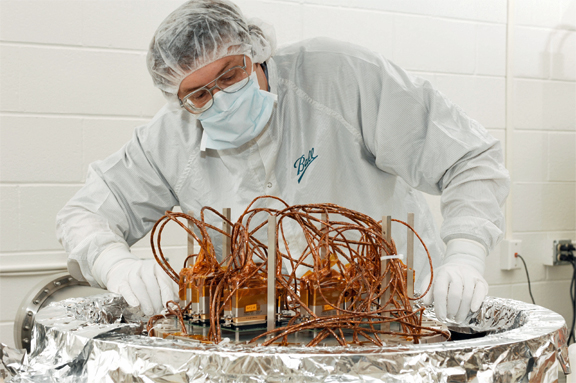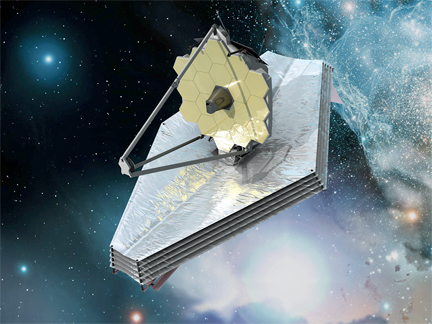“Nothing was typical about this innovative solution,” said Robert D. Strain, Ball Aerospace president. “To our knowledge, we are the only company that has ever created these kinds of electronics for a space telescope, and we’re proud of the ingenuity at Ball that enabled this breakthrough.”
Electronics on a spacecraft are usually kept warm, operating over a temperature range from 4°F to 131°F. The Webb electronics are collocated with each of the telescope’s 18 hexagonal cold primary mirror segments and therefore must be operated at the same temperature as the primary mirror segments. These temperatures are as low as -405°F (30K) in order to capture some of the earliest infrared light in the cosmos.

This photo of the Cryogenic Flight Electronic Boxes is courtesy of Ball Aerospace.
Ball, a principal subcontractor to Northrop Grumman Aerospace Systems, successfully undertook the challenge to design the Webb electronics to operate in a deep-freeze cryogenic environment, recognizing that existing components had yet to be proven for such a space mission and therefore a “how-to” manual was not available.
To create the 6.5-meter Webb aperture, the mirror segments must be aligned on orbit, requiring that a set of cryogenic actuators be mounted to each segment to control individual mirror positioning and curvature radius within one ten-thousandth the width of a human hair. To do that, all 132 actuators required multiple wires to carry power and instrumentation signals between the actuators and control electronics.
To meet all of these complex requirements, Ball located, tested and qualified off-the-shelf components for use in both a 30K cryogenic and a radiation environment to create a unique electronics architecture consisting of 22 cryogenic flight electronics boxes. Each box operates between 30K and room temperature to multiplex signals from the warm control electronics to one actuator at a time. Achieving this critical technological advancement for future spacecraft to explore the solar system also required:
-
Determining how to create a multiplex design essential to minimize wiring and reduce the thermal heat leak from the warm control electronics to the passively cooled region of the telescope
Reducing the mass of electronic cables by nearly 98 percent to effectively reduce overall mass of the spacecraft, and
Developing robust manufacturing processes to allow the boards to survive both launch loads and multiple thermal cycles from room temperature down to 30K.
The electronic boxes drive the telescope’s success because they also control the Secondary Mirror Assembly, the backplane wing and secondary mirror support structure latches, and the Webb’s deployable tower. The Ball team made all the electronics for the Webb cryogenic electronics boxes, from design to manufacture, to test, to integration onto the circuit boards and into the boxes.

Artistic rendition of the James Webb Space Telescope. Image is courtesy of the ESA (C. Carreau).
“We learned through this challenge that trying to unlock the secrets of the Universe can require difficult and amazing engineering on Earth,” said Strain.
Ball Aerospace is responsible for the Webb’s optical technology and lightweight mirror system. By the end of 2013, Ball is expecting to deliver all 18 beryllium primary mirror segments that comprise the telescope to Goddard Space Flight Center where they are planned to be integrated in 2015. In addition to the primary mirror, Ball has designed and delivered the secondary and tertiary mirrors, a fine steering mirror, and several engineering development units.
NASA’s Webb Telescope, the premier observatory of the next decade, is on track for an October 2018 liftoff.


